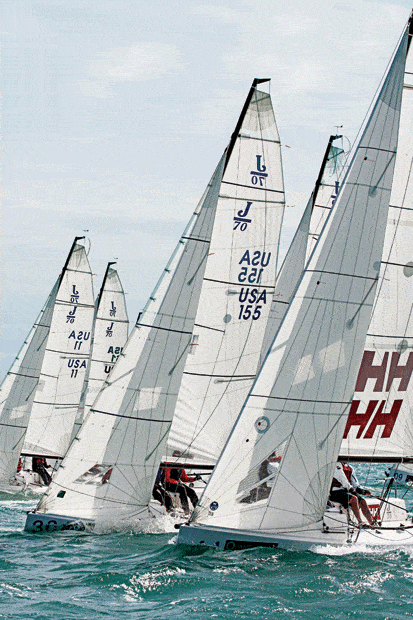
Horizon Job
It’s not a phrase I ever get to use, unless I’m on the receiving end. Most of us know that sinking feeling of being halfway up the first beat, scrapping for clear air while watching the race leader round the weather mark and take off down the run. At which point you think, “Those guys are launched. How the #%$ do they do it?” I recently got to experience how they do it, and I assure you that most of the hard work takes place before the race.
I was bowman on Tim Healy’s J/70 at Key West (p. 28), drafted days before the regatta. I sailed against Healy for years in our local J/24 fleet, but I’d never sailed with him. I knew he was fast, but I never realized how driven he is to being fast. His middle name should be Serious.
When he asked if I was available for Key West, my response was immediate and firm. “Yes. Definitely.” Key West with Tim Healy? I’m in.
Seconds after I hit the send button, though, the butterflies awoke. It’s a lot less stressful dropping into an unfamiliar team on a bigger boat: just ask questions, do your job, and pay attention. With a big team, a minor slip-up might go unnoticed in the chaos of a maneuver, but on a small, four-person keelboat, the skipper is always watching.
I arrived at the boat on the first morning with some trepidation. Would I meet Tim’s expectations? Would I fit in with the team? How could I contribute? As a sailmaker in the class’s first major event, there was a lot of pressure on Tim to deliver a good result. This was business, and in no way did I want to be responsible for him coming up short. So I did as my parents taught: smile and take the job no one else wants. I quickly volunteered for polishing duty, not an easy task when the boat is on its trailer. Sprawled out underneath the boat with gravel and sand grinding into my back, I buffed the McLube Speed Polish, being extra, extra careful not to miss a spot.
Meanwhile, my teammates, John Mollicone and Geoff Becker, tackled their own job lists: creating the rig-tune matrix and eliminating every possible excuse to fail. This continued into each day. Mollicone was the weight enforcer: not a single beer on this boat, nor extra screw or piece of line. Healy was the master of efficiency, ensuring we were the first ones on the racecourse, and using every minute of the morning commute to get a feel for the new boat. We lined up with anyone who wanted to, working on the most subtle crew mechanics, body positions, and sail trim changes, taking all the necessary steps to be ready.
On the second day, in a blustery 17 knots, a good start finally got us to the weather mark ahead of the fleet, but not by a lot. We exited the mark, set clean, planed for a few minutes on starboard, jibed to the leeward gate, rounded with a perfect douse, and sailed out to the favored left corner all alone. When we rounded the weather mark for the final run, there was no one around, but I could sense that Tim wasn’t about to relax.
After crossing the finish line I looked up the course, and there was a mile of empty water and whitecaps. Horizon job. I’ve always wanted to win a race by that much, and on any other boat I’m sure we would be Irish jigging in the cockpit, but Healy and the other guys just took it as a win. Fist bumps and a hushed “nice job guys” was all that was said, and it was straight to halyard clean up, sponging the half-ounce of water out of the bilge, and adjusting the rig for the next race. Apparently, that’s how it’s done.
– Dave Reed









